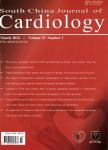Surgical outcomes of functional single ventricle with total anomalous pulmonary venous connection
Surgical outcomes of functional single ventricle with total anomalous pulmonary venous connection作者机构:Department of EpidemiologyGuangdong Cardiovascular InstituteWHO Collaborating Center for Research and Training in Cardiovascular DiseasesGuangdong Provincial Key Laboratory of South China Structural Heart DiseaseGuangdong Provincial People’s HospitalGuangdong Academy of Medical SciencesGuangzhou 510180GuangdongChina Department of Cardiac SurgeryGuangdong Cardiovascular InstituteWHO Collaborating Center for Research and Training in Cardiovascular DiseasesGuangdong Provincial Key Laboratory of South China Structural Heart DiseaseGuangdong Provincial People’s HospitalGuangdong Academy of Medical SciencesGuangzhou 510180GuangdongChina
出 版 物:《South China Journal of Cardiology》 (岭南心血管病杂志(英文版))
年 卷 期:2020年第21卷第1期
页 面:38-46,52页
学科分类:1002[医学-临床医学] 100202[医学-儿科学] 10[医学]
基 金:the National Key R&D Program of China(No.2018YFC1002600) National Natural Science Foundation of China(No.81903287) Natural Science Foundation of Guangdong Province(No.2018A030313329) the Science and Technology Planning Project of Guangdong Province(No.2017A070701013) the Science and Technological Program of Guangzhou,China(No.201704020126) Guangdong Medical Research Foundation(No.A2017328) Guangdong Provincial Administration of Traditional Chinese Medicine(No.20181004)
主 题:congenital heart defects functional single ventricle total anomalous pulmonary venous connection sutureless technique
摘 要:Background The surgical outcomes have been greatly improved over the past four decades for functional single ventricle(FSV). However,the repair for coexistence of FSV and total anomalous pulmonary venous connection(TAPVC),especially obstructed TAPVC,has remained a clinical challenge. Little is known about the results of surgical treatment for patients with FSV-TAPVC in China. Methods Forty consecutive patients with FSV-TAPVC undergoing initial surgical palliation(median age:16.8 months;body weight:8.25 kg)were retrospectively enrolled from 2006 to 2016 in a specialized cardiovascular institute. TAPVC was repaired in 30 patients. The mean follow-up period was 49 months. Results All of the 7 patients with preoperative pulmonary vein obstruction(PVO)underwent repair of TAPVC at the first operation and survived. When a systemic to pulmonary(S-P)shunt or pulmonary artery banding(PAB)was necessary,patients with concomitant TAPVC repair had lower mortality(30.0%)and higher total cavopulmonary connection completion rate(20.0%)than those without TAPVC repair[75.0% and 0%,respectively],although with no statistical significance(Fisher test,P=0.505 and P=0.245). The overall survival rates for the cohort at 1,3 and 5 years after the initial surgical intervention were 80.0%,77.1% and 77.1%,respectively. Multivariate COX regression analysis detected that SP shunt(adjusted odds ratio:6.51;95%CI:1.26-33.71,P=0.030)is the only risk factor for survival. The reintervention rate for postoperative PVO was higher in patients with preoperative PVO than those without(57.1%vs. 4.3%,Log Rank:P=0.006). Conclusion The mid-term results of surgical repair of FSV-TAPVC are still challenging. When PVO exists,surgical repair for TAPVC is suggested as soon as possible. Repair for TAPVC should also be considered when S-P shunt or PAB is necessary. Further study with larger population are warranted to support our finding.



